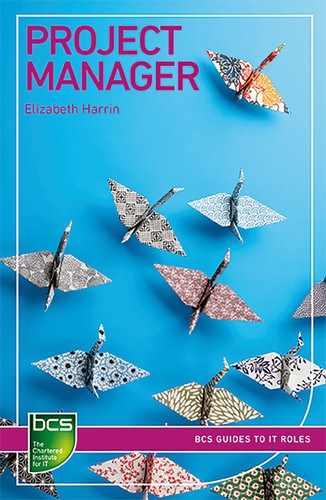1. Maslow, A. H. (1943) ‘A Theory of Human Motivation’. Psychological Review, 50, 370–396. Available at www.researchhistory.org/2012/06/16/maslows-hierarchy-of-needs (last accessed 8 August 2017).
2. PMI, Pulse of the Profession 2018, Success in Disruptive Times. Available at www.pmi.org/learning/thought-leadership/pulse/pulse-of-the-profession-2018 (last accessed 29 April 2018).
3. See www.girlsguidetopm.com/whats-the-profile-of-a-good-project-manager
4. Available at www.pmi.org/about/ethics/code
5. Available at www.apm.org.uk/about-us/how-apm-is-run/apm-code-of-professional-conduct
6. For more on SFIA®, see www.sfia-online.org
7. In this book I use ‘change control’ to refer to the process of managing in-project changes such as changes to requirements. ‘Change management’ is used to mean the wider business practice of facilitating the shift from current practice to new practice in order to achieve a benefit.
8. PRINCE2® uses the term ‘Executive’ to describe the person who has overall responsibility for ensuring the project meets its objectives. PRINCE2® does not have a specific role called ‘sponsor’ although it does acknowledge that the sponsor is probably going to be the person in the role of Executive, or the person who has put the Executive in post.
9. This definition is taken from my book, Communicating Change: How To Talk About Project Change (Bookboon, 2017).
10. There’s a step-by-step guide for this here: www.girlsguidetopm.com/a-complete-guide-to-raci-rasci-charts
11. There isn’t a single definition of what makes a project complex, but complex projects share a number of characteristics including lots of interfaces, ambiguity, uncertainty, emergent solutions, and environments where frequent change is common. A project can be complicated without being complex!
12. See www.agilealliance.org/glossary/backlog
13. See www.scrumalliance.org
14. For more on DSDM®, see the Agile Business Consortium website: www.agilebusiness.org/what-is-dsdm
15. Patton, J. and Economy, P. (2014) User Story Mapping. O’Reilly Media.
16. ITIL® is a proprietary form of IT service management. For more on ITIL®, see the AXELOS website: www.axelos.com/best-practice-solutions/itil
17. Burn-up charts work in the same way but instead of showing how much work is still to do, they show how much has been completed, so the graph line goes up instead of down.
18. See www.gartner.com/technology/research/methodologies/research_mq.jsp.
19. This is the result of my own research into how collaboration tools are used on projects. See www.girlsguidetopm.com/how-do-you-use-collaboration-tools-survey-results
20. Excellence, Achievement & Learning Limited: http://eal.org.uk
21. Available here: www.pmi.org/pmbok-guide-standards/foundational/pmbok/sixth-edition (last accessed 31 December 2017)
22. Available here: www.pmi.org/pmbok-guide-standards/foundational/pmbok/software-extension-5th-edition (last accessed 8 August 2017)
23. A historical note: Y2K (the ‘millennium bug’) was a perceived issue with software because many programs were created with dates hard coded as 19xx. There was concern that when 2000 came around, the software wouldn’t be able to deal with the date change and software failures would ensue. At the time, people were concerned about planes falling out of the sky and similar meltdowns. This was a busy time for IT project managers. Y2K passed largely without incident.
